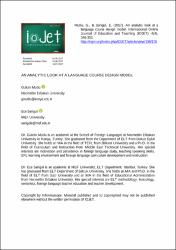Please use this identifier to cite or link to this item:
https://hdl.handle.net/20.500.11779/1041Full metadata record
| DC Field | Value | Language |
|---|---|---|
| dc.contributor.author | Gülçin Mutlu | - |
| dc.contributor.author | Ece Sarıgül | - |
| dc.date.accessioned | 2019-04-09T13:04:26Z | |
| dc.date.accessioned | 2019-04-09T15:14:46Z | |
| dc.date.available | 2019-04-09T13:04:26Z | |
| dc.date.available | 2019-04-09T15:14:46Z | |
| dc.date.issued | 2017 | - |
| dc.identifier.citation | Mutlu, G., & Sarigul, E. (2017). An analytic look at a language course design model. International Online Journal of Education and Teaching (IOJET), 4(4), ss.346-353 | en_US |
| dc.identifier.uri | https://hdl.handle.net/20.500.11779/1041 | - |
| dc.description | Ece Sarıgül (MEF Author) | en_US |
| dc.description.abstract | This study aims to qualitatively examine and elaborate on the characteristics of the course design model devised by Graves (2000). Drawing upon the traditional components and principals of instructional design, Graves' course design model is innovative or different in that it has been more specially developed for language course design purposes and thus is believed to be more suited to the nature of language courses with its consideration of the main elements or characteristics of language teaching and learning processes. This descriptive study centers upon the seven main examination criteria, which are in fact the main procedures as suggested by Graves (2000). These are a) defining context, b) conceptualizing content, c) organizing the course, d) formulating goals and objectives, e) assessing needs, f) developing materials and finally g) designing an assessment plan. In this essence, each criterion was first introduced and explained in detail before the researchers extend their critical outlook into the functionality and practical use of the relevant steps and strategies recommended by Graves (2000). This critical analysis and review on the Graves' course design model revealed that the model employs the traditional components of the ADDIE generic and lends itself well also to be used in the other disciplines other than foreign languages. The final part of this report will provide suggestions as regards the potential application of the model specifically in English language curriculum development and more broadly in the curriculum and course development procedures pertaining to other discipline areas. | en_US |
| dc.language.iso | en | en_US |
| dc.relation.ispartof | IOJET | en_US |
| dc.rights | info:eu-repo/semantics/openAccess | en_US |
| dc.subject | Course design model | en_US |
| dc.subject | English language teaching | en_US |
| dc.subject | Instructional | en_US |
| dc.title | An Analytic Look at a Language Course Design Model | en_US |
| dc.type | Article | en_US |
| dc.relation.publicationcategory | Makale - Ulusal Hakemli Dergi - Kurum Öğretim Elemanı | en_US |
| dc.identifier.endpage | 353 | en_US |
| dc.identifier.startpage | 345 | en_US |
| dc.identifier.issue | 4 | en_US |
| dc.identifier.volume | 4 | en_US |
| dc.department | Eğitim Fakültesi, İngilizce Öğretmenliği Bölümü | en_US |
| dc.identifier.trdizinid | 246224 | en_US |
| dc.institutionauthor | Ece Sarıgül | - |
| item.grantfulltext | open | - |
| item.fulltext | With Fulltext | - |
| item.languageiso639-1 | en | - |
| item.openairetype | Article | - |
| item.openairecristype | http://purl.org/coar/resource_type/c_18cf | - |
| item.cerifentitytype | Publications | - |
| Appears in Collections: | İngilizce Öğretmenliği Koleksiyonu TR-Dizin İndeksli Yayınlar Koleksiyonu / TR Dizin Indexed Publications Collection | |
Files in This Item:
| File | Description | Size | Format | |
|---|---|---|---|---|
| AN ANALYTIC LOOK AT A LANGUAGE COURSE DESIGN MODEL.pdf | Yayıncı Sürümü - Makale | 257.52 kB | Adobe PDF |  View/Open |
CORE Recommender
Page view(s)
22
checked on Nov 18, 2024
Download(s)
4
checked on Nov 18, 2024
Google ScholarTM
Check
Items in GCRIS Repository are protected by copyright, with all rights reserved, unless otherwise indicated.